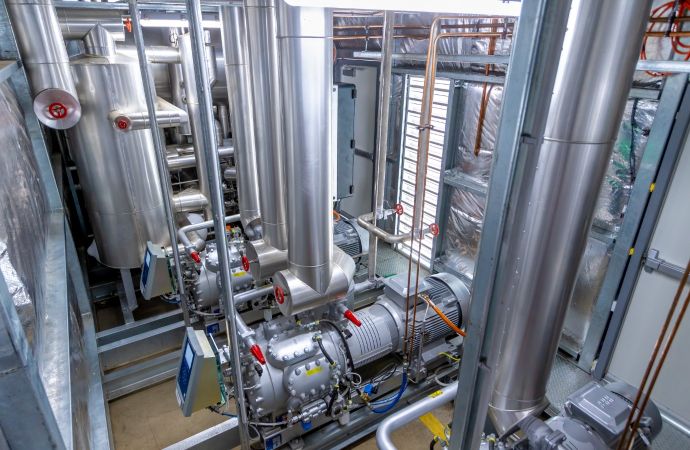Tracing the growth of natural refrigerants through the first 100 issues of Accelerate magazines from around the world.

HFCs are now being replaced by small scale low-charge ammonia systems in industrial refrigeration — such as the one shown here installed by Scantec Refrigeration in Australia.
This is Part 4 of a six-part series detailing how the use of natural refrigerants has grown around the world, taken from the cover story of the June 2019 edition of Accelerate Magazine.
In Australia and New Zealand, HVAC&R industry leaders began to experiment with CO2systems in the 1990s and early 2000s, following Europe’s lead. Australia’s first transcritical CO2 installation took place in 2007 at a Drakes Foodmarkets store in North Adelaide.
Since then, natural refrigerants progressed from pilot projects to HFC alternatives in these nations’ commercial and industrial sectors.
As in other parts of the world, policy helps give companies in Australia and New Zealand an incentive to phase down f-gases and find alternatives.
In October 2017, Australia ratified the Kigali Amendment to the Montreal Protocol, which commits it to phasing down HFC imports. (No HFCs are manufactured in Australia itself.)
Australia had prepared itself for the Kigali commitment in June 2017, when it passed a bill amending its Ozone Protection and Synthetic Greenhouse Gas Management (OPSGGM) Act by adding an HFC phase-down plan. Under the bill, Australia would begin to phase down imports of HFCs in January 2018. The phase down is being managed through an annual import quota that will gradually be reduced over 18 years. The end point, 15% of the baseline level, will be reached in January 2036.
In New Zealand, the government has amended its Emission Trading Scheme to accelerate an HFC phase down. HFC importers and manufacturers are this year facing increased levies and must apply for permits.
For 2019 the emission unit price under the New Zealand Emission Trading Scheme (NZ ETS) increased by 17% for HFC importers and manufacturers compared to last year. Since January 2019, businesses must pay NZ $25 (approximately $16 US) per emission unit.
Participation in the NZ ETS is mandatory for importers and manufacturers of HFCs operating as of January 2013.
Regulatory change has helped to intensify the search for marketready alternatives to HFCs. But from the beginning, it was clear that the higher cost of natural refrigerantbased systems was a barrier to their adoption. “What’s enabled progress is that we saw from the first project that we needed to drive costs down,” said Brian Toulson of City Holdings, which takes care of facilities management for Australian retailer Coles.
Engaging with overseas suppliers was crucial in reducing costs in the early days. “There was a perception that if we piggybacked on bulk suppliers and leading manufacturers globally, then we could drive costs down and benefit from their high-volume supplies,” Toulson said.
That is what City Holdings did for Coles, which installed its first transcritical CO2system in 2015. “We went over to see overseas manufacturers in their home countries, and sought commitments from them to bring staff over to help training and commissioning,” Toulson said. “It worked really well.”
On the other hand, Woolworths – another leading Australian retailer – took a more local approach. The company fully engaged local stakeholders in designing, installing and commissioning systems, which reduced installation time and standardized equipment.
Woolworths installed its first CO2 transcritical system in July 2017, in a store in Colebee, New South Wales (NSW). As training of local industry picked up, familiarity and confidence with transcritical CO2 systems began to grow (See “Woolworths building NatRef momentum in Australia,” Accelerate Australia & NZ, winter 2017).
Standardizing equipment, meanwhile, has also reduced on-site costs. For example, Woolworths’ second CO2 transcritical system, installed in a store in Wadalba, NSW, in July 2018, was built to an e-specification system, helping to cut installation and on-site risk management costs.
Both Coles and Woolworths have helped pave the way for Australia’s wider HVAC&R industry to adopt CO2 transcritical systems by showing how to reduce costs, facilitating training, and familiarizing stakeholders with the technology.
Shifting Mindset Among Independents
Not to be outdone by the two leading players, other food retailers active in Australia, including Aldi, Drakes and independent operators, have been moving towards natural refrigerants, too.
Smaller retailers are forced to be more cost-oriented than bigger players, which are often in a better position to invest in the future. Nonetheless, smaller firms are also mindful of how investing in certain types of equipment today can ultimately save costs in the long run. Discussions about future-proof technologies are therefore opening the door to natural refrigerants.
Petar Lujic, owner of IGA Market Central, summed up this sentiment in outlining his decision to go with natural refrigerants for a new store opened in November 2017. (See “One man’s vision,” Accelerate Australia & NZ, winter 2018). “It means that we can focus far more on running our business as opposed to worrying about efficiency or replacing equipment and changing refrigerants,” said Lujic. “That’s it.”
Bob Soang, general manager of Drakes, also seeks to take advantage of the long-term benefits of investing in natural refrigerant systems. (See “The big comeback,” Accelerate Australia & NZ, summer 2018.)
“The technology is actually modern and likely to carry you through much longer than that cheap and nasty, low-costbudget quick fix,” Soang said.
Progress in the Industrial Sector
Commercial refrigeration is not the only promising growth area in Australia. Natural refrigerants are also progressing in the industrial sector.
Nowadays, efforts are underway to reduce ammonia charges in industrial systems without compromising on energy efficiency – which in turn is attracting new customers to ammonia.
Scantec Refrigeration Technologies has been a pioneer in this space, designing and building the first stickbuilt, centralized low-charge ammonia system of Australia’s modern era in 2012-2013 for Bidford, a food service company, in Perth.
More recently, in October 2018, Scantec commissioned a central-type, two-stage, low-charge ammonia system in Mackay, North Queensland. The ammonia plant serves a cold storage and food service distribution facility and is, notably, “the smallest low-charge central system designed and constructed by Scantec so far,” according to Stefan Jensen, the firm’s managing director.
The Mackay system’s low- and medium temperature design capacities are each approximately 50 kW (14.2 TR), with a total ammonia charge of about 500 kg.
CO2 transcritical is also beginning to penetrate the industrial sector as new technologies enable it to serve higher capacities. For example, in November 2017, Danish system manufacturer Advansor’s first industrial transcritical CO2 rack in Australia was commissioned at a United Food Express cold storage warehouse in Melbourne (see “Up and running,” Accelerate Australia & NZ, summer 2018 edition).
Another option is to use ammonia and CO2 in tandem. F. Mayer Imports Pty Ltd., a food importer and wholesaler, opted for a transcritical CO2 plant with an ammonia chiller for its Melbourne distribution warehouse (see “F. Mayer reaping rewards of innovation“, Accelerate Australia & NZ, summer 2017).
This is Part 4 of a six-part series detailing how the use of natural refrigerants has grown around the world, taken from the cover story of the June 2019 edition of Accelerate Magazine.
Click here for Part 5: Japan – Eco Cute and C-Stores Lead NatRefs Growth
All posts in the series:
Part 1: NatRefs 101Part 2: Europe – Leading the World
Part 3: North America – Steady Growth, Despite Policy Setbacks
Part 4: Australia & New Zealand – Cutting Costs Down Under
Part 5: Japan – Eco Cute and C-Stores Lead NatRefs Growth
Part 6: China – NatRef Opportunities Abound
Related stories



